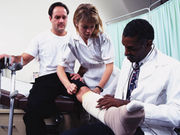Does not prevent venous thromboembolism after knee arthroplasty, casting of lower leg
MONDAY, Dec. 5, 2016 (HealthDay News) — The use of thromboprophylaxis seems not to prevent venous thromboembolism after knee arthroplasty or casting of the lower leg, according to a study published online Dec. 3 in The New England Journal of Medicine.
Raymond A. van Adrichem, M.D., from Leiden University Medical Center in the Netherlands, and colleagues conducted two parallel multicenter randomized trials with blinded outcome evaluation: the POT-KAST trial involving patients undergoing knee arthroscopy and the POT-CAST trial involving patients treated with casting of the lower leg. Patients were randomized to receive a prophylactic dose of low-molecular-weight heparin or no anticoagulant therapy.
The researchers found that venous thromboembolism occurred in 0.7 percent of patients in the treatment group and in 0.4 percent of patients in the control group in the POT-KAST trial (relative risk, 1.6; 95 percent confidence interval, 0.4 to 6.8). Major bleeding occurred in 0.1 percent of patients in each group. Venous thromboembolism occurred in 1.4 percent of the treatment group and 1.8 percent of the control group in the POT-CAST trial (relative risk, 0.8; 95 percent confidence interval, 0.3 to 1.7). There were no major bleeding events.
“Prophylaxis with low-molecular-weight heparin for the eight days after knee arthroscopy or during the full period of immobilization due to casting was not effective for the prevention of symptomatic venous thromboembolism,” the authors write.
Copyright © 2016 HealthDay. All rights reserved.








